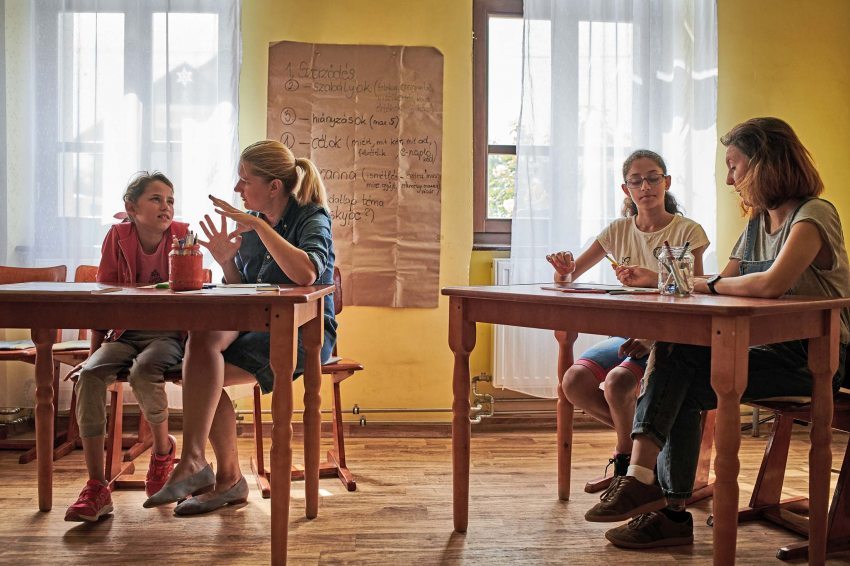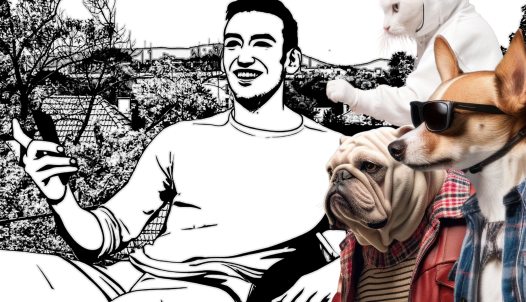120 volunteers working for children – InDaHouse in Hernádszentandrás
Hernádszentandrás is a village with a population of barely 400 located in the Hernád Valley, where schoolchildren starting the year are greeted not only by a beautiful rainbow but a handful of active young people. They are InDaHouse Hungary Association volunteers, who similarly to their 120 fellow volunteers help local children – most of Gypsy origin – to have a more secure future offering genuine choices. This is now the sixth year they have been active from September to June, at the weekends (including in the nearby village of Pere where they started). And they intend to stay for a while: since last May they have been building a house to serve as a base, exclusively from donations and through voluntary work. In fact, they are planning for decades to come.

After a trip of nearly 40 minutes from Miskolc, our train draws into Ináncs station at 11:30 am. This, along with Pere, Hernádbűd and Hernádszentandrás, is the fourth (and largest) village in the programme. We left Budapest on a cloudy morning yet here we are met by glorious sunshine. Social worker Fruzsina Benkő, founder of Jószolgálat Prize winning InDaHouse Hungary, meets us with the minibus. The fact that Fruzsi learnt to drive in order to be able to transport children around here perhaps says a lot about her commitment. As a deep-rooted Budapester, she moved to the village in the summer in order to supervise the construction work. She just left the building site of the Volunteer and Children’s Centre that she has long been dreaming of creating to come and collect us. In fact, today is an exciting day: if the weather stays fine, we can learn about adobe plastering from one of the local grandfathers. But let’s talk about that later.
Let’s contract!
Our first trip takes us to the special school where – as it is the start of the InDaHouse academic year – contracting with the children is already well underway. “Earlier, our school kids made vows, and now all of them talk about their annual (learning) targets with the help of volunteers, and together with acceptance of the main rules i.e. nobody hurts anybody, and at most five absences are permitted per term, all this is set down in writing,” Fruzsi explains. Until their own place is completed, in all likelihood in October, one of the buildings in the village hosts school classes, just as in the previous two academic years. The building was loaned by Hernádszentandrás local government.
From 10 am to 2 pm, children aged 6 to 16 - fifty-eight this year - take turns in 2-hour slots over the two days, with the first half hour of sessions spent in group play (outside in the courtyard in good weather), followed by individual coaching.
The latter is the result of well coordinated work: volunteers preparing test sheets on the basis of individual interest and difficulties of the children, mentors following the path of each child and volunteers either travelling here or teaching via Skype all work together from week to week.
All for one: Szabi makes it to grammar school
Bogi is 12 and starting her fifth academic year at InDaHouse (meanwhile, in 2016, she spent a year in Canada with her family), she likes learning, she gets top marks in most subjects, although she would like to improve her mathematics “to at least the best”. Her goal is to attend grammar school in Miskolc, although she would willingly learn the profession of hairdressing.
In fact, four students of InDaHouse started this academic year in grammar school as a result of extensive preparatory work and many conversations. Fruzsi reckons this is one of their biggest successes so far.
One of them, Szabi, studies in Budapest, although even here they stay in touch: thanks to donors, they are able to cover his necessary expenses and volunteers support him in transport and studying. “We have seen much more in him than anyone has ever seen before” Fruzsi says in response to my question about whether without them, Szabi would still have had the urge to attend grammar school. At the same time, she emphasizes that they are not forcing anything on anybody, they rather represent an attitude: “let somebody be a stonemason, but then let him be the best.”
“I receive emotion”
In the meantime, the first class is finished and then comes the news: one of the older girls, although already enrolled, does not want to come to school. Fruzsi drops everything and we go together to get Ramóna who, after revealing the problem, is prepared to come with us. Meanwhile, she tells us that they have been going to InDaHouse with her nine-year-old younger brother for several years and they have been on several summer camps. So it is not surprising that for the children, Fruzsi’s programme goes well beyond the improvement of study results. In InDaHouse they give a lot and receive a lot, as witnessed by the handwritten ‘term starting’ slips. For example, what? Love, attention, kindness. Mutual assistance. Emotion.
But they also receive experiences and presents. However, to get these requires persistence, commitment and the ability to go beyond what they thought possible. InDaHouse’s self-developed Manna system is designed to measure this.
The children collect stamps throughout the whole year – in line with their cooperation and diligence – thus getting them to the point where at the end of the year they can swap these for a much longed-for bicycle, for example, or a trip to Budapest.
In the course of the year, the excursion club set up this spring by one of the volunteers represents adventure for the kids: they learn about respect for nature and each other while trekking in Zemplén and Bükk. By overcoming their own fears, together they reach the summit, with each taking on a role – doctor, navigator, lead ant, rearguard – for the team.
20 days building – as a woman
It is two o’clock. Lunchtime. There is silence at the building site just a few metres from the school, only Dávid, one of the building volunteers, is digging an ever-bigger pit – it’ll soon become apparent what this is for. In fact, construction of the house – starting with the purchase of the plot and the small adobe brick house standing on it, which has become part of the new construct – is the result of until now unprecedented cohesion. Private and corporate donors have given around HUF 30 million including materials and it is not impossible that with the arrival of further secondary school and corporate groups, the number of volunteer helpers may even reach 600. Rooms required for children’s classes are located on the ground floor while volunteers (perhaps even long-term foreign helpers) can be accommodated on the upper floor in single-, double- and four-bed dormitories.
For the time being, the local government provides accommodation for volunteers travelling here. Fruzsi has fixed accommodation. We meet them at lunch. From them I find out that several of the school and early child development volunteers started at InDaHouse labouring on the building.
For example, since September last year 29-year-old Zsófi, who is studying for her PhD, has spent approximately 20 days here doing different jobs – tiling, partitioning, sanding – and she ‘debuted’ at the school today. She can travel down to Hernádszentandrás once a month. (A weekend lasts from Friday evening to Sunday evening, with volunteers arriving together from Budapest in the InDaHouse minibus.)
Visiting Nikó’s family
In addition to the six volunteers in the school and six working on construction, this weekend there are three volunteers going to homes of families living in Pere, Hernádszentandrás and Ináncs giving so-called early development training for children aged 0-6 years (about 50 kids in all).
This is particularly important because quite often children enter primary school with deficiencies in certain skills. Leaving from the InDaHouse guest house operating in Pere as a social enterprise, where the girls spend their lunchtime, we accompany Csenge and Alexa who have been working in the programme for a year, and the ‘new recruit’ Brigi, to the next family in Pere. Csenge said that the families were open to the visits and the volunteers quickly gained their confidence. We turn up with a huge bag full of various skill development games at the house of one-year-old Nikolasz, his two older siblings who go to school and their parents. While Alexa and the father of the baby deal with Nikó, the other two girls play with Amanda and Dominik who start school this week. Erzsó, their mother, reckons that the two older children developed enormously during their preparatory school year and they can hardly wait for first class in Szentandrás the following morning. Last year, Dominik built up enough points for a bicycle and he still hasn’t used up all his ‘stock’.
The long-awaited adobe plastering
We bid farewell to Alex and her colleagues and with the help of a local father taking over driving of the minibus we return to the building site where the abovementioned InDaHouse grandfather – in gratitude that his grandchildren can come here – teaches volunteers about the skill of adobe plastering. They have all been in the pit dug by Dávid for the past hour, joyfully trampling the clay ‘mined’ the day before with chaff. Soon it is time to start plastering the small adobe brick house.
Building work, that is in its second year, is expected to be finished in approximately two months, but the InDaHouse team won’t find themselves idle: thanks to a private donor, they can buy the small house in the village where, after renovation, they will realize another great dream, a community café.
This will give the older children the chance to learn about the world of work and enterprise. Besides this, Fruzsi and her partners would like to involve the village of Fügöd (with segregated school and kindergarten) belonging to the town of Encs in the programme within the next few years, but to achieve this they have to strengthen their human and financial resources. It is also important to guarantee long term the salaries of the three employees working full-time in the association. In other words, there are plenty of challenges ahead but the team’s diversity, creativity and persistence have already moved mountains.






